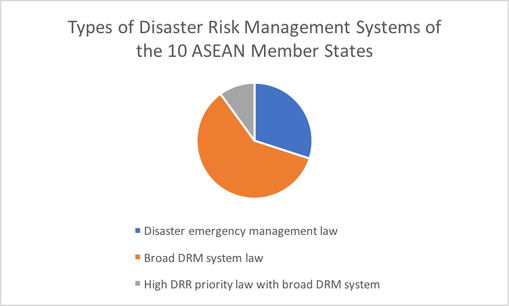National and local institutions
All of the ASEAN MS have national DRM systems established by laws that regulate disaster management and set up responsible institutions:
- All have national level institutions for DRM – national committees, and ministries or national disaster management agencies/civil defence forces
- Most have sub-national structures for district or local level DRM – committees, district or local branches of government administration, and district or local level national disaster management agencies/civil defence forces

There is a lot of variation between countries, due to different systems of law and government.
Common ground is that all require work on general public awareness on disaster risk, and training on disasters and preparedness.
There is a lot of variation between countries in these structures and the way laws establish them. This relates to:
- The type of government administration in place, how many levels it has and how autonomous they are.
- The style of laws each country. Some are very detailed laws. Others have framework laws that rely on regulations, decrees, orders and other types of secondary laws to provide the detail.
For example:
- All the ASEAN MS laws have at least general requirements for the DRM institutions to work on general public awareness on disaster risk, and training on disasters and preparedness
- All the ASEAN MS laws provide for personnel and other resources for capacity-building through mandated government agencies at the national level.
- Only some of the ASEAN MS laws talk about the DRM budget
- Only some of the ASEAN MS laws detail local and community level resources and capacity for DRM.
Capacity-building for disaster response
All the national DRM frameworks mandate a range of capacity building at national level, with a more mixed pattern for local government and community level. Some important observations about this are that:
- These answers are, for the most part, based on general DRM institutional mandates in the laws;
- This project information does not reflect practice, only law and policy.
- Lack of a specific legal mandate for sub-national capacity building does not mean it cannot be done, as broad national powers and budgets may cover it.
- Financial and budget aspects are most often dealt with by different institutional funding mechanisms outside the DRM framework. Most of the funding, personnel and equipment resources for DRM are part of the system institutions’ and/or government ministries’ annual budgets (examples of those with separate DRM funds are noted below).
- Not all the ASEAN MS have significantly decentralized local government powers or structures (e.g. Cambodia, Laos), while local government and community are sometimes the same level/structure (e.g. Viet Nam’s Local People’s Committees)
Preparedness
The analysis shows that:
- The ASEAN MS laws that establish their DRM systems put most emphasis on the national level mandates, and most of the responsibility is placed there.
- The sub-national levels, local government and community, have similar responsibilities to each other.
Even for the national level institutions, the laws are not very detailed about their responsibilities in national capacity building for disaster preparedness and response:
- The most common type of mandate for awareness and training is a general clause in the national law where it sets out the DRM institutions’ roles and responsibilities.
- The main form of resource-allocation (personnel, funds, materials and equipment), is through the governmental agencies’ annual budgets.
Domestic preparedness capacity-building - example for peer learning:
Response
Ready resources for response - examples for peer learning:
- The Philippine Disaster Risk Reduction and Management Act provides for both national and local DRRM funds, including ready funds and funds for risk reduction and mitigation.
- In Malaysia the Royal Malaysian Police Fire and Rescue Department is the lead agency in response, with the National Civil Defense Force as a second responder. This means there is expert and well-resourced response-ready capacity.
- Singapore has a response-ready standing national civil defense force which already has personnel, equipment and budget.
Institutional mandates
All of the ASEAN MS laws law and policy frameworks on DRM provide for national disaster response.
These include general provisions in the laws to ensure equipment, relief materials, human resources and financial resources for the disaster response.
Most of these are not separate powers or budgets. They are part of the responsibilities and budgets of the DRM institutions. But some ASEAN MS also establish separate ways to ensure ready response capacity.
Two main ways used to ensure ready resources for response are through special contingency funds or through having a fully equipped and trained emergency, rescue or civil defence force on standby.
![]()

